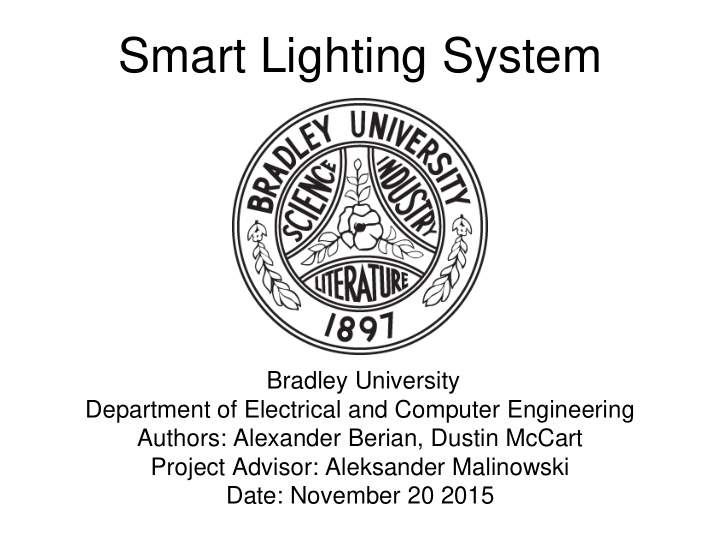



Smart Lighting System Bradley University Department of Electrical and Computer Engineering Authors: Alexander Berian, Dustin McCart Project Advisor: Aleksander Malinowski Date: November 20 2015
• Problem Description Overview • Division of Labor • System Block Diagram 2
Problem Description • Smart light switch • Replace ordinary light switches • Pattern recognition and utilization • Android smartphone application • Bluetooth • Wi-Fi • User interface panel • Buttons and Switches • Controlling high voltage lights http://www.fryeelectricinc.com • Light control circuit 3
Division of Labor 4
System Block Diagram 5
• Schedule • Work completed Progress • Light control circuit Alex Berian • User interface + Motion sensor 6
Schedule 7
Light Control Circuit 8
Light Control Circuit: Design • Transistor • 2N3904 • Relay switch • G5LE-1 DC5 • Diode • 1N4004 9
Light Control Circuit: Testing Theoretical Experimental V RELAY = 4.7V V RELAY = 4.73V i B = 2.5mA i B = 2.56mA 10
User Interface + Motion Sensor 11
User Interface + Motion Sensor: Design • LED • C5SME-RJS • Button • 401-1967-ND • Switch • 100SP1T1B4M2QE • Motion Sensor • leegoal Pyroelectric Infrared PIR 12
User Interface Circuit Theoretical i LED = 1.8mA i switch on = 0.33mA i switch off = 0A Experimental i LED = 1.127mA i switch on = 0.303mA i switch off = 0.56 μ A 13
• Work completed • Pin state setting • Work remaining Progress • Data storage finalization Dustin McCart • Prediction algorithm • Mode create • Combine all part into final program 14
Schedule 15
Pin Communication Information Utilizes wiringPI Library • Inputs • Outputs • • Toggle switches Light control signal • • Motion sensor Indicator LED status • 4 Push buttons 16
Communication Progress • Final test of board pin communication program 17
Prediction Algorithm Information • Using Transition Probability • Based on Master Thesis By Rolf Heukels • Predicting user behavior using transition probability • Algorithm • It is a three step algorithm 18
Algorithm First Step • First step is initial point distribution • Factors used in calculation: • Number of occurrences of each state • Similarity to current state 19
Algorithm Second Step • Second step is redistribution of points • Factors used in calculation: • Current time • Scope of scan • Past transitions • Total number of occurrences 20
Algorithm Third Step • Third step creates the actual prediction • Factors used in calculation: • Total number of points • Item to be predicted • All states definitions 21
Prediction Program Progress • Reading thesis to understand algorithm • MATLAB programming • MATLAB testing • C++ programming • Crosses with data storage development • Testing C++ program with test project • Comparing with MATLAB results and debugging 22
Data Storage Program Information • Items being stored are two arrays • Method chosen in class • Utilizes the C++ vector library 23
Storage Program Progress • Looked for different ways to store data • Create basic program • Asked Dr. Malinowski for information on creating class template for data storage • Converted storage method to class template • Created functions to interact with storage arrays 24
• Overall Team Conclusion Progress 25
Overall Team Progress 26
Questions • Alex Berian • Dustin McCart & Answers • Team 27
Extra Slides Alex Berian 28
User Interface Circuit Test 29
Motion Sensor Output 30
Android Application Layout 31
Light Control Circuit Test Setup 32
Relay Coil Voltage Spike 33
Light Control Circuit Calculations 34
User Interface Circuit Calculations 35
Extra Slides Dustin McCart 36
System Flow Chart 37
Recommend
More recommend